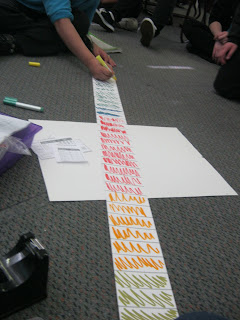 Fractions are always a tricky thing to teach students and sometimes can be a hard concept for students to grasp, especially equivalent fractions.
Fractions are always a tricky thing to teach students and sometimes can be a hard concept for students to grasp, especially equivalent fractions.
Again I like to teach equivalent fractions by using the concrete-pictorial-abstract approach.
This is an activity for teaching equivalent fractions using the concrete approach to begin. In a small teacher focus group, I handed out a bunch of scrap paper to each student.
I asked them first to fold the paper into half and shade in one half of the paper. That was easy. We left that paper alone and grabbed another sheet. I then asked the students to fold that paper into quarters. The instruction was then to shade in as many pieces of the sheet as needed to the same amount was shaded as the sheet for halves.
We repeated this activity for eighths.
The picture on the left is the result of our little experiment. A few students soon caught on that 1/2, 2/4, and 4/8 all represent the same size and are therefore equivalent fractions.
 This was an exciting activity for me as a teacher as I didn't tell the students we were going to learn about equivalent fractions. Rather, I sat back, gave the instructions and watched the students draw their own conclusions about the paper in front of them. It was wonderful to see the "Ah-ha!" moment on their faces when they were able to make the connection. This will definitely be an activity repeated in the future.
This was an exciting activity for me as a teacher as I didn't tell the students we were going to learn about equivalent fractions. Rather, I sat back, gave the instructions and watched the students draw their own conclusions about the paper in front of them. It was wonderful to see the "Ah-ha!" moment on their faces when they were able to make the connection. This will definitely be an activity repeated in the future. 














































